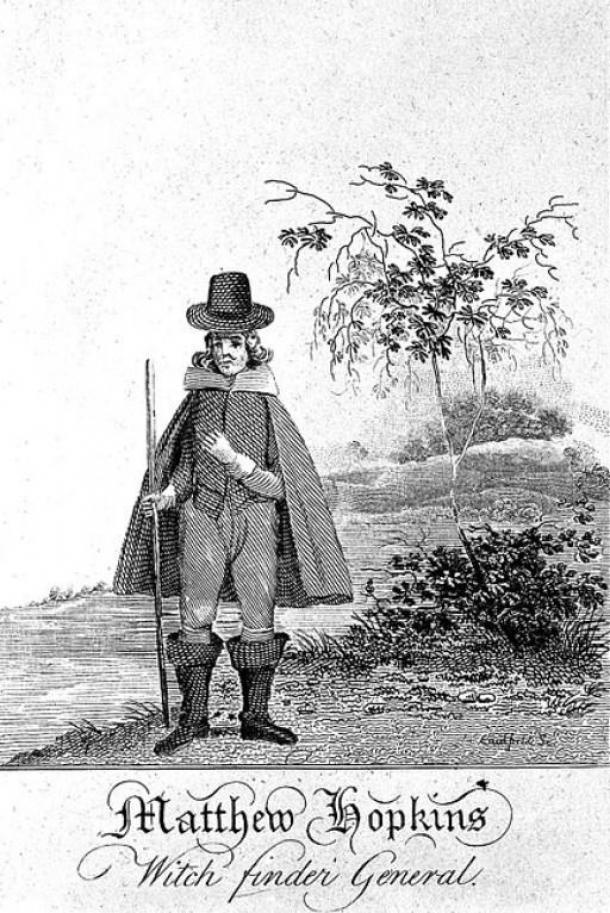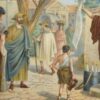🔴 Website 👉 https://u-s-news.com/
Telegram 👉 https://t.me/usnewscom_channel
The 17th century was a time of upheaval and uncertainty in England. Civil wars, religious divisions, and economic struggles gripped the country, creating a fertile breeding ground for fear and superstition. In the midst of this turbulence, one figure rose to infamy: Matthew Hopkins, England’s self-proclaimed “Witchfinder General.” Between 1645 and 1647, Hopkins was responsible for one of the most notorious witch-hunts in British history, during which hundreds of women, and in some cases men, were accused of witchcraft. Many of them ended their lives at the gallows. But who was this man, and how did he manage to wield such influence during this period of fear and paranoia?
The Making of a Witchfinder
Born around 1620 in the small village of Great Wenham, Suffolk, Matthew Hopkins was the son of a Puritan minister. Little is known about his early life, but it is believed that he received a modest education and may have trained as a lawyer. By the time he surfaced in historical records in 1644, Hopkins had moved to Manningtree, Essex, where his first witch-hunting activities began.
In a small, rural community like Manningtree, gossip could spread quickly, and fears of witchcraft were often just beneath the surface. In March 1644, Hopkins claimed to have overheard local women discussing their meetings with the Devil. These accusations snowballed, and Hopkins, alongside his assistant John Stearne, was soon investigating suspected witches in the surrounding areas.
Hopkins appointed himself “Witchfinder General,” though this title was entirely self-created. He convinced villages across East Anglia that witches lived among them, offering his services in rooting out these dangerous individuals. His investigations, however, were not acts of justice but rather driven by fear, superstition, and, some argue, financial motivation. Hopkins charged towns for his services, and there is evidence that his witch-hunting efforts earned him a considerable sum of money for the time.
Portrait of Matthew Hopkins, witch-finder general. (Wellcome Images/ CC BY-SA 4.0)
Witch-Hunting Methods
The methods Hopkins used to identify and extract confessions from suspected witches were brutal, though less violent than some of the torture techniques used in continental Europe. His preferred techniques included “watching” the accused, where suspects were deprived of sleep for days on end, and the infamous “swimming test.”
The swimming test was particularly notorious. The belief behind this test was that witches, having renounced their baptism, would be rejected by water. The accused were bound and thrown into a body of water. If they floated, they were deemed guilty of witchcraft; if they sank, they were considered innocent but often drowned in the process. Another common method was pricking the accused’s skin, searching for “Devil’s Marks,” which were thought to be areas where witches’ familiars (often animals like cats or toads) fed on their blood. Hopkins employed prickers, often using blunt or retractable blades to create the illusion that certain areas of the skin were insensible, further “proving” the accused’s guilt.
Torturing and execution of witches in medieval miniature. (Public Domain)
Hopkins also looked for witch’s familiars, which were believed to be spirits that assisted witches in their dark deeds. These familiars were thought to be animals that witches sent to harm others, and Hopkins’ investigations often involved neighbors testifying that they had seen strange creatures lurking near the accused.
These methods may seem laughable today, but at the time, they were accepted by a fearful and superstitious population. Under these extreme conditions, many accused individuals confessed, either to stop the torment, or out of sheer desperation.
Driven by Religion and Law?
One aspect of Hopkins’ life that adds depth to his character is the possibility that his actions were influenced by both religious and legal motivations. Raised as the son of a Puritan minister, Hopkins was almost certainly steeped in the strict moral teachings of Puritanism. Puritans believed strongly in the fight against sin and anything that might be linked to the Devil. For Hopkins, witch-hunting may have represented a form of religious duty, purging communities of evil influences in line with the Puritan vision of a godly society.
Witchcraft practices. (Public Domain)
Hopkins’ suspected legal background also played a role in shaping his approach. Though there is no definitive evidence that he was a practicing lawyer, some accounts suggest he had legal training. His methodical and structured approach to gathering evidence, extracting confessions, and preparing cases for trial suggest that he was familiar with legal procedures. This knowledge allowed him to operate effectively, gathering testimonies, coercing confessions, and presenting his findings to the courts, all while navigating the legal channels available to him.
While Hopkins did not have the authority to convict witches himself, his skills in accumulating evidence and manipulating legal loopholes ensured that he could play a pivotal role in prosecuting those accused of witchcraft. His combined motivations—rooted in religious fervor and possible legal expertise—allowed him to present himself as a legitimate enforcer of both moral and judicial order.
Fear and Superstition in 17th Century England
To understand how Hopkins could wield such power, it’s essential to consider the broader context of the time. England was in the midst of a civil war between Royalists, who supported King Charles I, and Parliamentarians, who opposed him. The conflict was deeply intertwined with religious divisions, and Puritanism, with its stern morality and focus on rooting out sin, was gaining influence.
This period was rife with anxiety. Economic hardships, failed harvests, and outbreaks of disease added to the prevailing sense of dread. People were desperate for answers, and in many cases, they found a convenient scapegoat in witches. Accusing someone of witchcraft provided an outlet for frustration and fear, and Hopkins exploited this environment to further his witch-hunting career.
The Essex Trials and Beyond
In 1645, Hopkins and Stearne embarked on a witch-hunting spree that covered much of East Anglia, including Essex, Suffolk, Norfolk, and Cambridgeshire. One of the most significant trials they were involved in took place in Chelmsford, Essex. In this trial, 29 women were accused of witchcraft, and 15 of them were found guilty and hanged. Hopkins and Stearne provided much of the evidence used to convict these women, and their reputation as successful witch hunters continued to grow.
While women were overwhelmingly the victims, men also fell afoul of Hopkins’ methods. One notable case was that of John Lowes, an 80-year-old clergyman from Suffolk. He had been outspoken in his opposition to the witch hunts and, as a result, became a target himself. Accused of sinking a ship using witchcraft, Lowes was subjected to sleep deprivation and forced to walk continuously. After enduring days of torture, he confessed to witchcraft and was subsequently executed.
The peak of Hopkins’ influence came during the Bury St Edmunds witch trial, where 18 people, including two men, were convicted of witchcraft and executed. These trials were notable not only for the number of executions but also for the widespread fear they generated across East Anglia. People who had previously been neighbors and friends turned on each other, with accusations flying as fear and suspicion spread.
Title page of report of the 1662 Trial, incorrectly dated as 1664. (Public Domain)
Hopkins’ Role in the Prosecutions
While many believe Hopkins acted as a judge and directly convicted witches, this was not the case. Hopkins’ role was more about gathering evidence and creating a case against the accused, which was then presented to the courts. Alongside his associates, Hopkins would collect testimonies from neighbors, coercing confessions from the accused through various methods like “watching” or the swimming test. Once he had accumulated enough “evidence,” Hopkins would hand over the accused to the local courts.
It was the courts, not Hopkins, that ultimately convicted and sentenced the accused witches. However, Hopkins’ involvement in these prosecutions was instrumental. His work provided the bulk of the evidence that led to convictions, and his fearmongering helped fuel the hysteria that swept through East Anglia. Though Hopkins did not have the legal authority to convict anyone, his influence in the prosecution process was undeniable.
Criticism and Decline
While Hopkins initially gained support for his actions, it didn’t take long for his methods and motivations to come under scrutiny. One of his most vocal critics was John Gaule, a clergyman from Great Staughton. Gaule argued that Hopkins was overstepping his authority and accused him of profiting from the misery of others. Gaule’s sermons against Hopkins raised awareness about the questionable tactics being used in the witch hunts and the sheer number of innocent people who were being condemned.
By 1646, Hopkins was facing increasing resistance. His methods were questioned by local magistrates, and there were concerns about whether his witch hunts were motivated more by profit than by a genuine desire for justice. Hopkins defended his actions in his 1647 book The Discovery of Witches, in which he laid out his methods and justified his approach to witch-hunting. However, the tide was turning against him.
That same year, Hopkins retired to Manningtree, where he died from tuberculosis on August 12, 1647. Despite rumors that he had been subjected to his own swimming test and executed as a witch, historical records confirm that he died of illness.
Witch Finder General, from a broadside published by Matthew Hopkins before 1650. (Public Domain)
The Legacy of Matthew Hopkins
Matthew Hopkins’ witch-hunting career may have lasted only a few short years, but its impact was significant. It is estimated that he and his associates were responsible for the execution of more than 100 people, a staggering number compared to previous witch trials in England. His actions left a lasting scar on East Anglia, where communities were torn apart by fear and suspicion.
Hopkins’ legacy is a cautionary tale about the dangers of superstition and fear in times of social upheaval. His methods, while extreme, were a reflection of the beliefs of the time, and his success can be seen as a symptom of a society in crisis. Although the witch hunts in England eventually came to an end, Hopkins’ name remains synonymous with paranoia, religious zealotry, and the dark side of human nature.
Conclusion
The story of Matthew Hopkins serves as a reminder of how fear and ignorance can lead to horrific consequences. His witch hunts, conducted under the guise of justice, exploited the superstitions of a vulnerable population. While his methods may seem absurd by today’s standards, Hopkins was able to convince an entire region that witches posed a serious threat. His legacy continues to fascinate historians and the public alike, as it sheds light on one of the darker chapters in British history.
Top image: Witchfinder spread fear across ancient England. AI Generated image. Source: ChimE/Adobe Stock
References
Castelow, Ellen. Matthew Hopkins, Witch-Finder General. History UK.
Gaskill, Malcolm. Witchfinders: A Seventeenth-Century English Tragedy. John Murray Publishers, 2005.
Gaule, John. Select Cases of Conscience Touching Witches and Witchcrafts. London, 1646.
Hay, Shana. The Historical Significance of Matthew Hopkins: England’s Witchfinder General. 2022.
Hopkins, Matthew. The Discovery of Witches. London, 1647.
Robbins, Rossell Hope. The Encyclopedia of Witchcraft and Demonology. Crown Publishers, 1959.
Sharpe, James. Instruments of Darkness: Witchcraft in England, 1550-1750. University of Pennsylvania Press, 1997.
Easton, Henrietta. Matthew Hopkins: The Real Witchfinder General. 2022.





